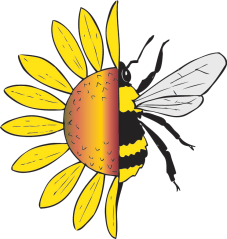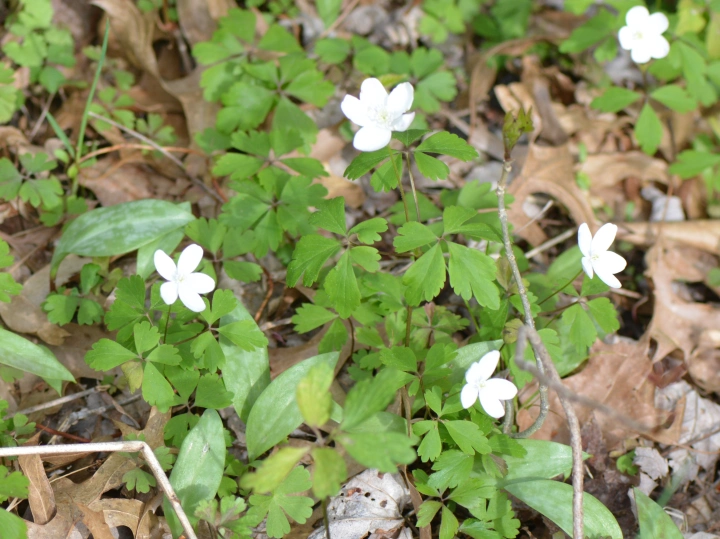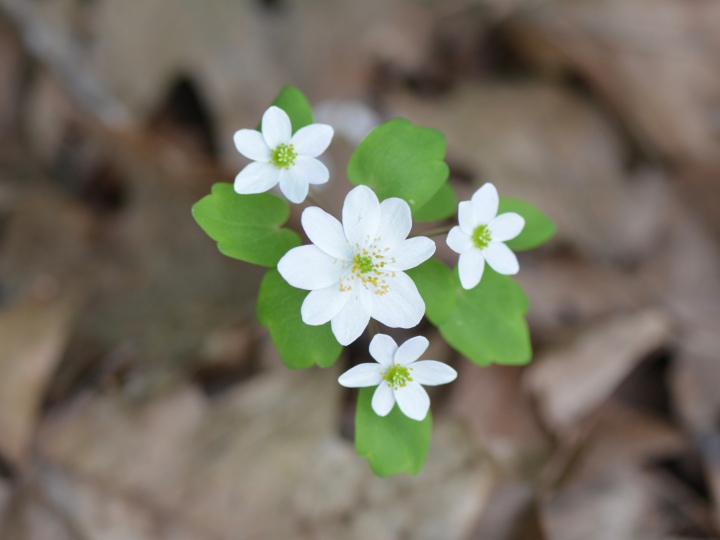The springtime forest comes alive with the woodland flowers blooming before the leaf canopy darkens the forest floor. Many of these early blooming flowers provide the essential resources needed for emerging bees and flies. Wood Anemone (Anemone quinquefolia) and Rue Anemone (Thalictrum thalictroides) are two flowers often mistaken for one another and they both share the common name anemone a Greek word that means, breathe or live.
Wood Anemone (Anemone quinquefolia) is a native woodland ephemeral that blooms in early spring before the leaf canopy shades the forest floor. They have white flowers held aloft on slender stalks that tremble in the breeze earning them the name Wind Flowers. The leaves are compound and have three deeply lobed leaflets that are course toothed. Due to the deep lobes the leaf appear to have four or five leaflets. It has long been believed that wood anemone does not produce nectar however, it was 2013 study* recently discovered that Anemone nemerosa from Europe does produce nectar that attract bee flies. It can be assumed that Anemone quinquefolia also produces nectar that attracts bee flies since it is closely related to their European counterpart, Anemone nemerosa. The flowers also attracts bees such as mining bees and sweat bees as observed in Stewart State Forest near Newburgh, NY.
Rue Anemone (Thalictrum thalictroides) is another native woodland ephemeral that blooms around the same time as wood anemone and their flowers look nearly identical. Instead of one flower rue anemone can have multiple flowers on a stalk. The leaves are very different from wood anemone and more similar to meadow rue, three leaflets with three blunt lobes. The flowers produce no nectar but attract pollen collecting bees and flies. Bloodroot is another spring flower that does not produce nectar. With little floral competition in early spring some ephemerals forego high energy nectar production to offer pollen only. In Native Beeology’s observations in James Baird State Park in Lagrange, NY, no pollinator’s were observed visiting the flowers though a diversity of bees and flies awere found pollinating other spring flowers like trout lily.
Both Anemone produce seeds that contain elaisomes that provide nourishment for insects encouraging them to spread the seeds far and wide. Ants in particular take the seeds back to their ant colony and eat the elaisomes and discard the seeds. Since viable seeds are not easily produced the plants spread via underground rhizomes and rue anemone’s starchy roots earned them the name of Wild Potato. Apparently, a delicacy popular in some places. Beware, both plants are members of the buttercup family Ranunculaceae and most parts are mildly toxic. This toxicity makes these spring flowers deer resistant and a good candidate for a woodland garden. Enjoy the beauty of the two anemones as their flowers tremble in the breeze of a early spring day.
References:
Erbar, Claudia & Leins, Peter. (2013). Nectar production in the pollen flower of Anemone nemorosa in comparison with other Ranunculaceae and Magnolia (Magnoliaceae). Organisms Diversity & Evolution. 13. 10.1007/s13127-013-0131-9.
Categories: solitary bees, spring ephemerals, Spring woodland flowers






